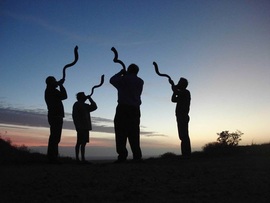 I never much liked preparing for the High Holy Days, but I loved them when they arrived. Especially as I became more adept at managing the long services with the flow of so many dear people in, out and through, there was a poetry to the days that was independent of the liturgy and the sacred tasks at hand. I had the privilege to work with some terrific partners in the pulpit over the years (none better than hazzan who is yet at the synagogue I served) and a few people whose sincerity may have exceeded their talent. But it was the crowd before me that made the real difference. Each person came with two agendas – the official orders of the day, printed in the prayer book, and the personal priorities that impelled them to the synagogue. The list of items was limited: penitence, reflection, fashion, gossip, musical inspiration, display of (grand)children, and so on. The combination was unique in every congregant and part of the symphony of the day. To succeed, I needed three things: services that provided ample opportunity for prayer, an inspirational set of messages and an eye on the clock. The first years in my most recent pulpit were not successful in that last item. The later years, thanks to pre-labeled post-it notes, allowed me to plan for the following season by tracking the actual amount of time it took to, say, do the full introductory service until the Torah service. (1:20, by the way). And even though the services for the first and second days of Rosh HaShanah are virtually identical, the scriptural readings for the second day are actually about twenty minutes shorter. Now you know. The year after I stepped away from the pulpit was an emotionally difficult time. In my opinion, the transition was poorly handled all around. But my family knew we needed to be somewhere else for the High Holy Days, so we wound up with a short term rental on the Upper West Side in New York. We spent those holidays at the services of the Jewish Theological Seminary among a relatively intimate group of less than 400. After all, most of the rabbis and not-yet-rabbis were off conducting services in parts unknown. I was among a few friends and a lot of strangers. The experience was like none I ever had. I credit the leaders – Julia Andelman, Alan Cooper, Danny Nevins and Lauren Henderson – with presence that was both gentle and intense. But I credit myself with letting go of my role as manager. And when I did, the liturgy flowed through me like a river. It washed over me like first love. It infiltrated my body – head and heart, eyes and ears, limbs and lips. Words and phrases jumped off the page and danced for me. Ideas I had considered aloud 100 times or more climbed into my tear ducts and baled streams down my cheeks. Freed of the responsibility to beat the clock, maintain (Jewish) law and order and keep everyone on the same page (literally), I became just a Jew in the pew. I was grateful. Absolutely, I was grateful to JTS for the experience of worship, but at least as much I was grateful to the decades of preparation for those moments. Without the engagement from the pulpit, I likely would not have had such engagement off the pulpit. Judging from the size of my long-time congregation, only one in a thousand people has my experience. I am that one. But over the years, I heard expressions of gratitude from lots of the other 999. They were grateful for lots of different things, flowing from those unique agendas. (I heard complaints, too, but fewer than you might imagine). So I have come to understand that this annual pageant, lauded and lampooned, is a collective conspiracy. It has a stated purpose: to get individuals and the community right with God. But whether or not any or all of us believe that literally, High Holy Day services are also the Walmart of Judaism. (Ouch. Macy’s? Harrod’s? Amazon?) They are the place for certain business to be conducted that serves the local franchise and the larger endeavor, but does so only if they can provide what every individual comes looking to find. Congregants pretend to come for the purpose of prayer, and rabbis and cantors are complicit in that pretense. But the fact is that prayer is most the excuse for people to come together; it is the one thing they all have in common. However, it is not necessarily the primary reason for anyone…except maybe the rabbi. Accidentally, I guess I became the enabler of all of those private agendas. In the process, my High Holy Day experience became not so much prayerful devotion as it was managing the prayer experience for others. I had my few moments, tucking myself into a less-visible nook and creating private space with my large tallit pulled over my head, or free-falling into the chanting of “Avinu Malkeinu,” broken-heartedly aware that we need charity and love because our good deeds fall so short of our potential. But once I relinquished that role to others, I rediscovered what I probably knew before page numbers and post-it notes – I was happy to be present for the collective endeavor as long as I got what I needed in the process. That’s as it should be, and not just for the pious of Israel, but for the co-conspirators from all aspects of Jewish life, too.
0 Comments
|
AuthorI spent 35 years in the pulpit and learned a few things about the people and the profession Archives
July 2023
Categories |

 RSS Feed
RSS Feed
